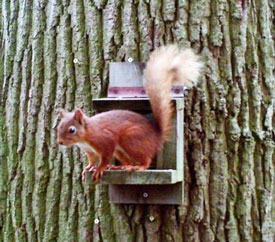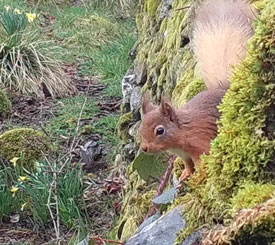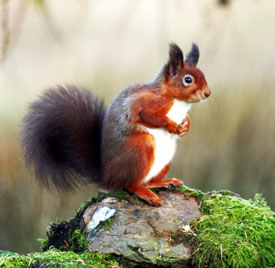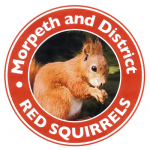 In 2016, the MADRS grey control team removed 720 greys from our patch. 2017 has seen an increase in greys, no doubt greatly contributed to by such a mild winter and to the end of June, we had removed over 900. The damage to trees, predation on bird eggs and fledgelings and obviously the spread of squirrel pox would have been so much greater had it not been for the remarkable efforts of our ‘Grey’ team. We are indebted to each and every one of them, as quite simply, without this control work, we would have lost our Reds by now. It is only through this continued and relentless work that the native Red has any chance of survival. Encouragingly, we have had more red sightings in areas where we have been undertaking control work and I am delighted to say that 2 Reds, in two different areas near Shadfen were seen recently.
In 2016, the MADRS grey control team removed 720 greys from our patch. 2017 has seen an increase in greys, no doubt greatly contributed to by such a mild winter and to the end of June, we had removed over 900. The damage to trees, predation on bird eggs and fledgelings and obviously the spread of squirrel pox would have been so much greater had it not been for the remarkable efforts of our ‘Grey’ team. We are indebted to each and every one of them, as quite simply, without this control work, we would have lost our Reds by now. It is only through this continued and relentless work that the native Red has any chance of survival. Encouragingly, we have had more red sightings in areas where we have been undertaking control work and I am delighted to say that 2 Reds, in two different areas near Shadfen were seen recently.
Again, we stress that this is not a side of red conservation that is taken lightly. It is absolutely necessary to ensure the survival of the reds.
It would seem that all the various ‘official’ organisations and the plethora of acronyms that go with them are all essentially reinventing the wheel and patting themselves on the back about saving the Red squirrel. It is however a reality, that the majority of ‘saving’ the red squirrel is down to the sheer hard work and ‘boots on the ground’ from local groups. Without this extensive effort, these funded organisations would have nothing to save. It is a pity that the majority of the salaried people sitting behind desks in these organisations seem oblivious to this. Read more>>
Category: News & Newsletters
Westmorland Red Squirrels E-News – August 2017
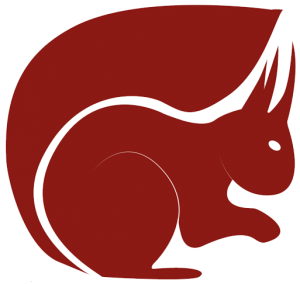 Welcome to our August edition. Red squirrel sightings have rocketed this year. By the end of June 2016 we’d had just 86, although the figure recovered to 244 by the end of the year. In 2017, however, we have already had 309 reported, with five months to go. These reports are essential for mapping red squirrel range so please keep them coming. Read more>>
Welcome to our August edition. Red squirrel sightings have rocketed this year. By the end of June 2016 we’d had just 86, although the figure recovered to 244 by the end of the year. In 2017, however, we have already had 309 reported, with five months to go. These reports are essential for mapping red squirrel range so please keep them coming. Read more>>
P&DRSG – Newsletter August 2017

Many of you will have seen or heard so much in the way of press releases over the last six months or so regarding a contraceptive for grey squirrels, a vaccine to save red squirrels from squirrel pox virus disease and also the Pine Marten theory of creating a ‘landscape of fear’ for the greys.
As it stands currently; a workable contraceptive formula is at least a decade away and even if this comes to fruition, it is of no use to our group as cannot be used in areas where there are red squirrels; there is no funding available to develop the prototype of the squirrel pox vaccine any further; and there is no statistically significant evidence relating to the Pine Marten theory.
The only way to save the much loved red squirrels in our area is through human intervention using the successful methods that we deploy. Our standardised recording data provides very clear, significant evidence that using a humane, combination methodology of trapping and shooting is the most effective means of clearing areas of the non-native grey squirrels to allow our iconic and genetically unique red squirrels to survive for future generations to enjoy. It is this dedicated ‘boots on the ground front line work’ that is making the biggest impact in red squirrel conservation. Read more>>
Mid Wales Red Squirrel Partnership Red Squirrel News – Summer 2017
 In this edition of Red Squirrel News, find out what the red squirrels on our trail cams have been up to, where red squirrels have been seen recently and and how you can get involved in tracking reds in mid Wales. VWT Pine Marten Project Manager, Jenny MacPherson gives advice on how to avoid getting a pine marten in your traps, and what action to take if you do. Get the lastest information on Phytophthora ramorum disease how Natural Resounces Wales (NRW) are trying to limit the impact on our woodlands. Read more>>
In this edition of Red Squirrel News, find out what the red squirrels on our trail cams have been up to, where red squirrels have been seen recently and and how you can get involved in tracking reds in mid Wales. VWT Pine Marten Project Manager, Jenny MacPherson gives advice on how to avoid getting a pine marten in your traps, and what action to take if you do. Get the lastest information on Phytophthora ramorum disease how Natural Resounces Wales (NRW) are trying to limit the impact on our woodlands. Read more>>
Westmorland Red Squirrels E-News – June 2017

Non-lethal control is unlikely ever to replace trapping and shooting entirely as a way to suppress greys. But fertility control and natural predation offer attractive and additional ‘tools in the toolbox’. Research by Giovanna Massei at the National Wildlife Management Centre, part of the Animal & Plant Health Agency unit based outside York, is moving existing fertility control science to the point where a strategy for grey squirrels can be applied. The 5-year research programme uses existing and proven US developed contraceptives married with leading edge British oral delivery technology. A key component of the research will be the development of a grey squirrel-specific hopper, delivering the oral contraceptive on treated feed. Here is Giovanna’s full report>>
Read more of the WRS E-News here>>
‘Kill them, kill them, kill them’: the volunteer army plotting to wipe out Britain’s grey squirrels
The red squirrel is under threat of extinction across Britain. Their supporters believe the only way to save them is to exterminate their enemy: the greys. But are they just prejudiced against non-native species? By Patrick Barkham and published in theguardian. Read the article here>>
Courtesy of Guardian News & Media Ltd
‘Squirrel’ published by ESI – Issue 34, April 2017
 Figures published earlier this year show that in strategically systematic and coordinated programmes carried out in the north of England, grey squirrel control is most effective when a combination of trapping and shooting is used, with shooting proving to be the most effective aspect of control. Read more>>
Figures published earlier this year show that in strategically systematic and coordinated programmes carried out in the north of England, grey squirrel control is most effective when a combination of trapping and shooting is used, with shooting proving to be the most effective aspect of control. Read more>>
Westmorland Red Squirrels E-News – April 2017
 Welcome to our first E-News. Our plan is to issue it every couple of months with the exception of February each year when we’ll produce an Annual Review. What do you think of this new way of keeping in touch? Please let us know. Read more>>
Welcome to our first E-News. Our plan is to issue it every couple of months with the exception of February each year when we’ll produce an Annual Review. What do you think of this new way of keeping in touch? Please let us know. Read more>>
Grey squirrels are bad for the British countryside – full stop
A very interesting article making the case for grey control, written by Dr Craig Shuttleworth and published in The Conversation. Read the full article here>>
The Conversation UK is a not-for-profit, registered charity, sharing knowledge from the world’s best universities with a diverse, global audience of readers
Mid Wales Red Squirrel Partnership Red Squirrel News- Spring 2017
 It’s been quite a while since the last issue of Red Squirrel News. Staff attention has been focused on the coordination of a management plan for the Mid Wales Red Squirrel Focal Site. There was no winter issue of Red Squirrel News this year, but that means there’s plenty of things red-squirrelly to cover in this spring issue!
It’s been quite a while since the last issue of Red Squirrel News. Staff attention has been focused on the coordination of a management plan for the Mid Wales Red Squirrel Focal Site. There was no winter issue of Red Squirrel News this year, but that means there’s plenty of things red-squirrelly to cover in this spring issue!
Find out how the MWRSP is working with the forest industry in the Tywi area to help to retain and restore habitat for the benefit of red squirrels. Discover where some of the pine martens brought to Wales from Scotland by the Vincent Wildlife Trust have established territories. Find out about the new Red Squirrels United Project and how it is working to save red squirrels across the UK. Learn about new red squirrel sightings near to Llanddewi Brefi, in the west of the Focal Site, and how this might be an indication of the growing health of this key population. Read the latest info from the British Association for Shooting and Conservation (BASC) on their Trap Loan Scheme and how they are working with MWRSP to create a ‘buffer to the buffer’ for the Red Squirrel Focal Site, enabling further protection for our red squirrels from grey squirrels. Read more>>

